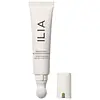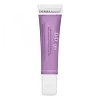What's inside
What's inside
 Key Ingredients
Key Ingredients

 Benefits
Benefits

 Concerns
Concerns

 Ingredients Side-by-side
Ingredients Side-by-side

Water
Skin ConditioningCaprylic/Capric Triglyceride
MaskingPersea Gratissima Oil
Skin ConditioningPropanediol
SolventGlycerin
HumectantPentylene Glycol
Skin ConditioningCetearyl Alcohol
EmollientCandelilla/Jojoba/Rice Bran Polyglyceryl-3 Esters
EmulsifyingJojoba Oil/Macadamia Seed Oil Esters
Skin ConditioningBrassica Campestris/Aleurites Fordi Oil Copolymer
Skin ConditioningSilica
AbrasiveGlyceryl Stearate
EmollientSodium Polyacryloyldimethyl Taurate
Emulsion StabilisingBehenyl Alcohol
EmollientCaffeine
Skin ConditioningMoringa Oil/Hydrogenated Moringa Oil Esters
Skin ConditioningSodium Stearoyl Lactylate
EmulsifyingMica
Cosmetic ColorantHydroxyacetophenone
AntioxidantCaprylyl Glycol
Emollient1,2-Hexanediol
Skin ConditioningSqualene
EmollientCaprylic/Capric/Succinic Triglyceride
EmollientXanthan Gum
EmulsifyingCitric Acid
BufferingSodium Phytate
Phytosteryl Macadamiate
Skin ConditioningPersea Gratissima Fruit Extract
EmollientCrithmum Maritimum Extract
Skin ConditioningPhytosterols
Skin ConditioningTocopherol
AntioxidantAcetyl Hexapeptide-8
HumectantSodium Citrate
BufferingCI 77891
Cosmetic ColorantCI 77491
Cosmetic ColorantWater, Caprylic/Capric Triglyceride, Persea Gratissima Oil, Propanediol, Glycerin, Pentylene Glycol, Cetearyl Alcohol, Candelilla/Jojoba/Rice Bran Polyglyceryl-3 Esters, Jojoba Oil/Macadamia Seed Oil Esters, Brassica Campestris/Aleurites Fordi Oil Copolymer, Silica, Glyceryl Stearate, Sodium Polyacryloyldimethyl Taurate, Behenyl Alcohol, Caffeine, Moringa Oil/Hydrogenated Moringa Oil Esters, Sodium Stearoyl Lactylate, Mica, Hydroxyacetophenone, Caprylyl Glycol, 1,2-Hexanediol, Squalene, Caprylic/Capric/Succinic Triglyceride, Xanthan Gum, Citric Acid, Sodium Phytate, Phytosteryl Macadamiate, Persea Gratissima Fruit Extract, Crithmum Maritimum Extract, Phytosterols, Tocopherol, Acetyl Hexapeptide-8, Sodium Citrate, CI 77891, CI 77491
Titanium Dioxide
Cosmetic ColorantZinc Oxide
Cosmetic ColorantAlbizia Julibrissin Bark Extract
MaskingAloe Barbadensis Leaf Juice
Skin ConditioningAlumina
AbrasiveAminomethyl Propanol
BufferingArgania Spinosa Kernel Oil
EmollientBisabolol
MaskingC12-15 Alkyl Benzoate
AntimicrobialCaffeine
Skin ConditioningCandelilla/Jojoba/Rice Bran Polyglyceryl-3 Esters
EmulsifyingCaprylic/Capric Triglyceride
MaskingCaprylyl Glycol
EmollientCellulose Gum
Emulsion StabilisingCeramide Ng
Skin ConditioningCetearyl Alcohol
EmollientCitric Acid
BufferingCoco-Caprylate
EmollientCocos Nucifera Oil
MaskingDarutoside
Skin ConditioningEthylhexylglycerin
Skin ConditioningGlycerin
HumectantHexylene Glycol
EmulsifyingCI 77491
Cosmetic ColorantCI 77492
Cosmetic ColorantCI 77499
Cosmetic ColorantIsostearic Acid
CleansingJojoba Esters
EmollientLauryl Glucoside
CleansingLecithin
EmollientMica
Cosmetic ColorantMicrocrystalline Cellulose
AbsorbentPalmitoyl Hexapeptide-12
Skin ConditioningPhenoxyethanol
PreservativePhytic Acid
Polyglyceryl-2 Dipolyhydroxystearate
Skin ConditioningPolyglyceryl-3 Polyricinoleate
EmulsifyingPolyhydroxystearic Acid
EmulsifyingSodium Stearoyl Lactylate
EmulsifyingStearic Acid
CleansingTocopherol
AntioxidantTocopheryl Acetate
AntioxidantTribehenin
EmollientWater
Skin ConditioningXanthan Gum
EmulsifyingTitanium Dioxide, Zinc Oxide, Albizia Julibrissin Bark Extract, Aloe Barbadensis Leaf Juice, Alumina, Aminomethyl Propanol, Argania Spinosa Kernel Oil, Bisabolol, C12-15 Alkyl Benzoate, Caffeine, Candelilla/Jojoba/Rice Bran Polyglyceryl-3 Esters, Caprylic/Capric Triglyceride, Caprylyl Glycol, Cellulose Gum, Ceramide Ng, Cetearyl Alcohol, Citric Acid, Coco-Caprylate, Cocos Nucifera Oil, Darutoside, Ethylhexylglycerin, Glycerin, Hexylene Glycol, CI 77491, CI 77492, CI 77499, Isostearic Acid, Jojoba Esters, Lauryl Glucoside, Lecithin, Mica, Microcrystalline Cellulose, Palmitoyl Hexapeptide-12, Phenoxyethanol, Phytic Acid, Polyglyceryl-2 Dipolyhydroxystearate, Polyglyceryl-3 Polyricinoleate, Polyhydroxystearic Acid, Sodium Stearoyl Lactylate, Stearic Acid, Tocopherol, Tocopheryl Acetate, Tribehenin, Water, Xanthan Gum
Ingredients Explained
These ingredients are found in both products.
Ingredients higher up in an ingredient list are typically present in a larger amount.
Caffeine is most associated with coffee, tea, and cacao. In skincare, it helps with calming inflammation and is rich in antioxidants.
While caffeine is used to treat cellulite and and dark circles, further studies are needed to prove this. It has been believed to help with these skin conditions due to its ability to dilate blood vessels and increase blood flow.
Some studies are looking into caffeine's ability to protect against UV rays.
Learn more about CaffeineCandelilla/Jojoba/Rice Bran Polyglyceryl-3 Esters isn't fungal acne safe.
This ingredient is an emollient, solvent, and texture enhancer. It is considered a skin-softener by helping the skin prevent moisture loss.
It helps thicken a product's formula and makes it easier to spread by dissolving clumping compounds.
Caprylic Triglyceride is made by combining glycerin with coconut oil, forming a clear liquid.
While there is an assumption Caprylic Triglyceride can clog pores due to it being derived from coconut oil, there is no research supporting this.
Learn more about Caprylic/Capric TriglycerideCaprylyl Glycol is a humectant and emollient, meaning it attracts and preserves moisture.
It is a common ingredient in many products, especially those designed to hydrate skin. The primary benefits are retaining moisture, skin softening, and promoting a healthy skin barrier.
Though Caprylyl Glycol is an alcohol derived from fatty acids, it is not the kind that can dry out skin.
This ingredient is also used as a preservative to extend the life of products. It has slight antimicrobial properties.
Learn more about Caprylyl GlycolCetearyl alcohol is a mixture of two fatty alcohols: cetyl alcohol and stearyl alcohol. It is mainly used as an emulsifier. Emulsifiers help prevent the separation of oils and products. Due to its composition, it can also be used to thicken a product or help create foam.
Cetearyl alcohol is an emollient. Emollients help soothe and hydrate the skin by trapping moisture.
Studies show Cetearyl alcohol is non-toxic and non-irritating. The FDA allows products labeled "alcohol-free" to have fatty alcohols.
This ingredient is usually derived from plant oils such as palm, vegetable, or coconut oils. There is debate on whether this ingredient will cause acne.
Due to the fatty acid base, this ingredient may not be Malassezia folliculitis safe.
Learn more about Cetearyl AlcoholCi 77491 is also hydrated iron III oxide. It's sole purpose is to give a red/pink hue to products.
Iron III oxides are classified as inorganic chemicals for coloring.
Synthetically created Ci 77491 is considered safer than those naturally found. This is because the synthetically created version may contain less impurities. Iron oxides are generally non-toxic and non-allergenic.
Learn more about CI 77491Citric Acid is an alpha hydroxy acid (AHA) naturally found in citrus fruits like oranges, lemons, and limes.
Like other AHAs, citric acid can exfoliate skin by breaking down the bonds that hold dead skin cells together. This helps reveal smoother and brighter skin underneath.
However, this exfoliating effect only happens at high concentrations (20%) which can be hard to find in cosmetic products.
Due to this, citric acid is usually included in small amounts as a pH adjuster. This helps keep products slightly more acidic and compatible with skin's natural pH.
In skincare formulas, citric acid can:
While it can provide some skin benefits, research shows lactic acid and glycolic acid are generally more effective and less irritating exfoliants.
Most citric acid used in skincare today is made by fermenting sugars (usually from molasses). This synthetic version is identical to the natural citrus form but easier to stabilize and use in formulations.
Read more about some other popular AHA's here:
Learn more about Citric AcidGlycerin is already naturally found in your skin. It helps moisturize and protect your skin.
A study from 2016 found glycerin to be more effective as a humectant than AHAs and hyaluronic acid.
As a humectant, it helps the skin stay hydrated by pulling moisture to your skin. The low molecular weight of glycerin allows it to pull moisture into the deeper layers of your skin.
Hydrated skin improves your skin barrier; Your skin barrier helps protect against irritants and bacteria.
Glycerin has also been found to have antimicrobial and antiviral properties. Due to these properties, glycerin is often used in wound and burn treatments.
In cosmetics, glycerin is usually derived from plants such as soybean or palm. However, it can also be sourced from animals, such as tallow or animal fat.
This ingredient is organic, colorless, odorless, and non-toxic.
Glycerin is the name for this ingredient in American English. British English uses Glycerol/Glycerine.
Learn more about GlycerinMica is a naturally occurring mineral used to add shimmer and color in cosmetics. It can also help improve the texture of a product or give it an opaque, white/silver color.
Serecite is the name for very fine but ragged grains of mica.
This ingredient is often coated with metal oxides like titanium dioxide. Trace amounts of heavy metals may be found in mica, but these metals are not harmful in our personal products.
Mica has been used since prehistoric times throughout the world. Ancient Egyptian, Indian, Greek, Roman, Aztec, and Chinese civilizations have used mica.
Learn more about MicaThis ingredient also goes by the name SSL. It is a non-toxic, biodegradable ingredient made from renewable sources.
SSL is typically used as a surfactant and emulsifier in skincare to stabilize water-based formulas and improve texture. It can be synthetic or animal-derived.
Tocopherol (also known as Vitamin E) is a common antioxidant used to help protect the skin from free-radicals and strengthen the skin barrier. It's also fat soluble - this means our skin is great at absorbing it.
Vitamin E also helps keep your natural skin lipids healthy. Your lipid skin barrier naturally consists of lipids, ceramides, and fatty acids. Vitamin E offers extra protection for your skin’s lipid barrier, keeping your skin healthy and nourished.
Another benefit is a bit of UV protection. Vitamin E helps reduce the damage caused by UVB rays. (It should not replace your sunscreen). Combining it with Vitamin C can decrease sunburned cells and hyperpigmentation after UV exposure.
You might have noticed Vitamin E + C often paired together. This is because it is great at stabilizing Vitamin C. Using the two together helps increase the effectiveness of both ingredients.
There are often claims that Vitamin E can reduce/prevent scarring, but these claims haven't been confirmed by scientific research.
Learn more about TocopherolWater. It's the most common cosmetic ingredient of all. You'll usually see it at the top of ingredient lists, meaning that it makes up the largest part of the product.
So why is it so popular? Water most often acts as a solvent - this means that it helps dissolve other ingredients into the formulation.
You'll also recognize water as that liquid we all need to stay alive. If you see this, drink a glass of water. Stay hydrated!
Learn more about WaterXanthan gum is used as a stabilizer and thickener within cosmetic products. It helps give products a sticky, thick feeling - preventing them from being too runny.
On the technical side of things, xanthan gum is a polysaccharide - a combination consisting of multiple sugar molecules bonded together.
Xanthan gum is a pretty common and great ingredient. It is a natural, non-toxic, non-irritating ingredient that is also commonly used in food products.
Learn more about Xanthan Gum